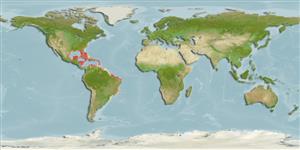Preferred temperature (Ref.
123201): 24.4 - 28, mean 27 °C (based on 254 cells).
Phylogenetic diversity index (Ref.
82804): PD
50 = 0.5001 [Uniqueness, from 0.5 = low to 2.0 = high].
Bayesian length-weight: a=0.00759 (0.00466 - 0.01235), b=3.04 (2.90 - 3.18), in cm total length, based on LWR estimates for this species & (Sub)family-body (Ref.
93245).
Niveau trophique (Ref.
69278): 2.7 ±0.4 se; based on diet studies.
Résilience (Ref.
120179): Haut, temps minimum de doublement de population inférieur à 15 mois (Preliminary K or Fecundity.).
Fishing Vulnerability (Ref.
59153): Low vulnerability (10 of 100).
Nutrients (Ref.
124155): Calcium = 166 [74, 326] mg/100g; Iron = 0.879 [0.427, 1.743] mg/100g; Protein = 17.7 [15.7, 19.4] %; Omega3 = 0.0941 [, ] g/100g; Selenium = 28.8 [13.0, 66.9] μg/100g; VitaminA = 115 [28, 450] μg/100g; Zinc = 2.44 [1.56, 3.66] mg/100g (wet weight);
